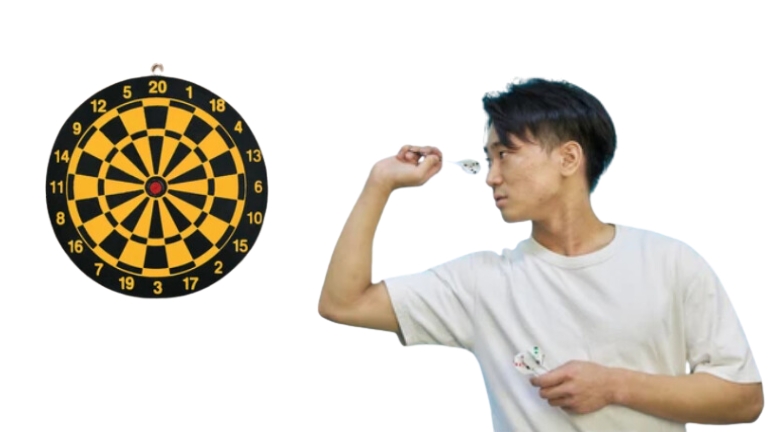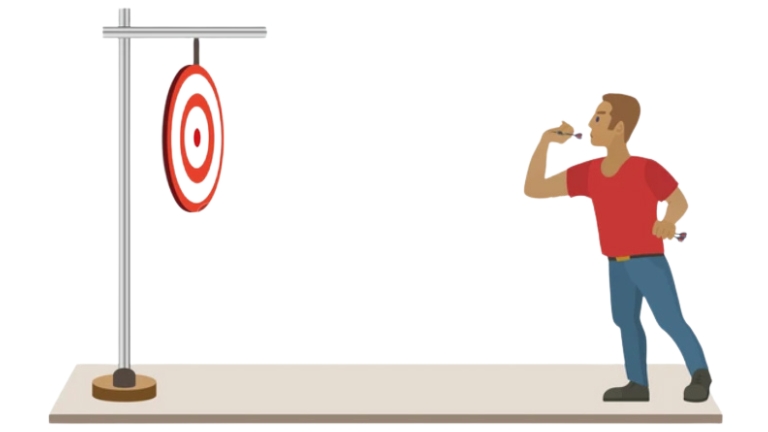Playing darts is a very enjoyable, popular, and competitive hobby that is loved by people all over the world. Whether you’re playing first time or professionally at a pub, in a team, or at your house, learning how to throw a dart well can make the game more fun and help you do better. This guide will show you the simple steps and techniques to throw darts properly and get better at the game.
The Proper Throwing Stance
A proper throwing stance gives you steadiness and balance, letting you concentrates on your throw without being concerned about moving your body. In darts, even a tiny change in your weight or where you place your feet can greatly affect where the dart hits. Here’s how to throw a dart correctly, with the right standing and body movement.
- Stand with your feet pointed away from the area where you’re going to throw and towards the side of the room.
- If you step forward with your right foot and your big toe is just behind the line, then you are right-handed. Your left foot will be just behind your right foot.
- If you are left-handed, then your left foot will be in front and your right foot will be behind it.
- Put your stronger hand forward and let it rest loosely next to your stronger foot. If you are right-handed, then your right hand should face forward. If you are left-handed, then your left hand should face forward.
- It’s fine if your back heel lifts a little off the ground in this stance. Just make sure you don’t lift your back foot and keep your weight on it.
- Standing directly facing the dartboard isn’t the best stance. You can throw more correctly by facing the side of the dartboard.
- Imagine a line going straight down from the middle of the dartboard to the floor. Point the front of your foot towards that imaginary line. This will help your dart throws stay accurate and straight.
- Don’t move your other foot in the wrong direction. Even if your front foot is pointed forward, your torso should still be slightly inclined to the side.
- If you’re unsure about where to put your front foot for each throw, you can use your shoe to make a mark on the ground to remember the spot.
- Don’t hunch or push your hips backward. Make sure your shoulders and hips are aligned directly above each other. Always maintain a straight line with your shoulders, hips, and legs when throwing darts.
- Some people who play darts like to bend their upper body a little bit over the line where they throw, so they feel more comfortable and closer to the dartboard. You can try this, but make sure your legs or feet stay behind the throw line. Be careful not to lean too far forward, as it could affect your stance and your throw.

The Techniques of the Gripping and Aiming the Dart
Gripping and aiming a dart are fundamental aspects of playing darts well. Here’s an overview of techniques serially for both:
- Use a minimum of three fingers to grasp the dart’s barrel. The elevated section of the dart that is closest to the center is called the barrel.
- Using your thumb, forefinger, and middle finger, grasps the dart’s barrel. If you want a more secure grasp, you may then hold it at the end of the barrel with your ring finger.
- You can then also hold it at the end of the barrel with your ring finger if you want a more stable grip.
- Do not hold the dart by its pointed end or its back part, which is called the flight.
- When holding the dart, keep your fingers straight and open, not curled.
- Remember, a dart that has a shorter part where you hold it usually needs fewer fingers to hold it properly. A dart with a longer part where you hold it might need more fingers to keep a good grip.
- Hold the dart gently, and not so hard that your fingers become pale or stiff. Darts is more about feeling than strength. Your grip should be just strong enough to hold the dart steady and give you control.
- If you are unsure, then choose a looser grip rather than a tight one. You can always make it a little tighter if needed.
- Hold the dart at eye level. Move your front arm forward while holding the dart with your fingers.
- Keep your shoulder steady as you lift the dart to eye level, slightly to the side of your eye. Confirm your elbow is aiming towards the dartboard.
- Your shoulder, elbow, and hand should be in line, creating a 90-degree angle, with your elbow a bit higher.
- Raise the front end of the dart a little. Make sure the back end of the dart stays tilted up, pointing towards the dartboard. Don’t let the front end fall down or sideways, because that will change where you’re aiming.
- Aim the dart straight at the place on the board where you want it to land. Don’t try to aim to the right or left of your target, because that often results in a bad throw.
- Use your dominant eye to help you aim better. Your main eye is usually the one on the same side as your main hand. If you’re right-handed, your right eye is your main eye. To aim better, look at the board with only your main eye open and keep the other eye closed.
The Methods for Releasing the Dart
Releasing the dart is a critical part of the throwing process. A smooth, consistent release is essential for accuracy. Here are some techniques and tips to help you master the dart release:
- Hold the dart with your hand and wrist. Move your hand a little backward when you release it.
- Use your hand, wrist, and elbow to make it fast. Keep your shoulder steady to help you. Put more pressure on your front foot when you let go of the dart.
- Don’t tilt or shift to the side. Stay still and upright. Only your arm should be in motion when you release the dart.
- Your elbow might go up a bit when you throw the dart. That’s alright, as it could happen because of the strength of your throw.
- After you let go of the dart, keep your arm moving in the same direction as the throw. Point your fingers towards your target or towards the floor.
- Let your arm stay in the air for a short time before you lower it. This helps you keep a good throwing position at the end of your throw.

Selecting the Right Darts
Selecting the right darts is important for getting a good throw at the game and enjoying it more. The first choice you need to make is whether to use steel-tip or soft-tip darts. Steel-tip darts are for the old-fashioned bristle boards, and soft-tip darts are for electronic boards. This is an important choice because it matches your darts with the right kind of dartboard.
After that, think about the material of the barrel. Serious players usually prefer tungsten because it’s dense and lasts a long time. Tungsten is a great material for accuracy because it may have narrower barrels, which result in tighter groupings on the board. A tungsten content of 80-90% gives you a good mix of performance and durability, making the darts feel high-quality and more accurate.
The weight of the dart is very important for darts throwing. Darts usually weigh between 12 and 50 grams, and many players like darts that are in the middle range, around 18 to 24 grams. Lighter darts need a gentler throws and have a higher curve, which is good for beginners. On the other hand, heavier darts are more stable and work better for experienced players who can handle a stronger throw.
The shape of the barrel and the grip are very individual preferences. Some people like a straight, round barrel because it feels consistent, while others may choose a barrel that narrows or curves to fit their hand better. The grip can be smooth, textured, or have ridges, and the best option is one that feels secure and comfortable to hold.
Lastly, think about the length of the shaft and the shape of the flight. Shorter shafts allow for quicker, more direct throws, whereas longer shafts give better control and steadiness. The shape of the flight affects how the dart flies, with regular flights providing more lift and steadiness, and thin flights allowing for faster, smoother throws.
Frequently Asked Questions (FAQs)
What is the distance to throw a dart?
In most competitive dart games, players stand 7 feet and 9 1/4 inches (or 2.37 meters) away from the dartboard, measured from the front of the board to the line where they stand. This is the usual distance for games using steel-tip darts. For soft-tip darts, the distance is typically a bit shorter, about 8 feet.
Is there a secret to throwing darts?
Yes, there is a secret to throwing darts. Keep your body upright and avoid bending too far forward. Face the dartboard directly and focus with both eyes. Position your elbow in a way that feels comfortable as you lower the hand holding the dart from above your head.
How can I improve at darts?
To improve at darts, practice regularly with a focus on consistency and accuracy. Develop a stable stance and a smooth throwing motion, aiming to hit the same spot repeatedly. Learn the basics like; how you hold the dart, how you stand, and when you let go.
During practice, focus on particular spots like the center or important scoring areas. Look at your performance, find areas where you need to improve and work on them step by step. Keep a good attitude and be patient because getting better requires time and effort.
Do you push or throw a dart?
Basically, there are two primary techniques for throwing a dart: pushing and throwing. To start, you should move your arm gently in a straight line toward your intended target. After that, with a quick flick of your wrist, release the dart toward the target.
It’s important to avoid pushing too hard, as this can cause the dart to wobble. Often, a lighter throw can yield better results. A smooth and controlled release will help maintain the dart’s stability and enhance your accuracy.

